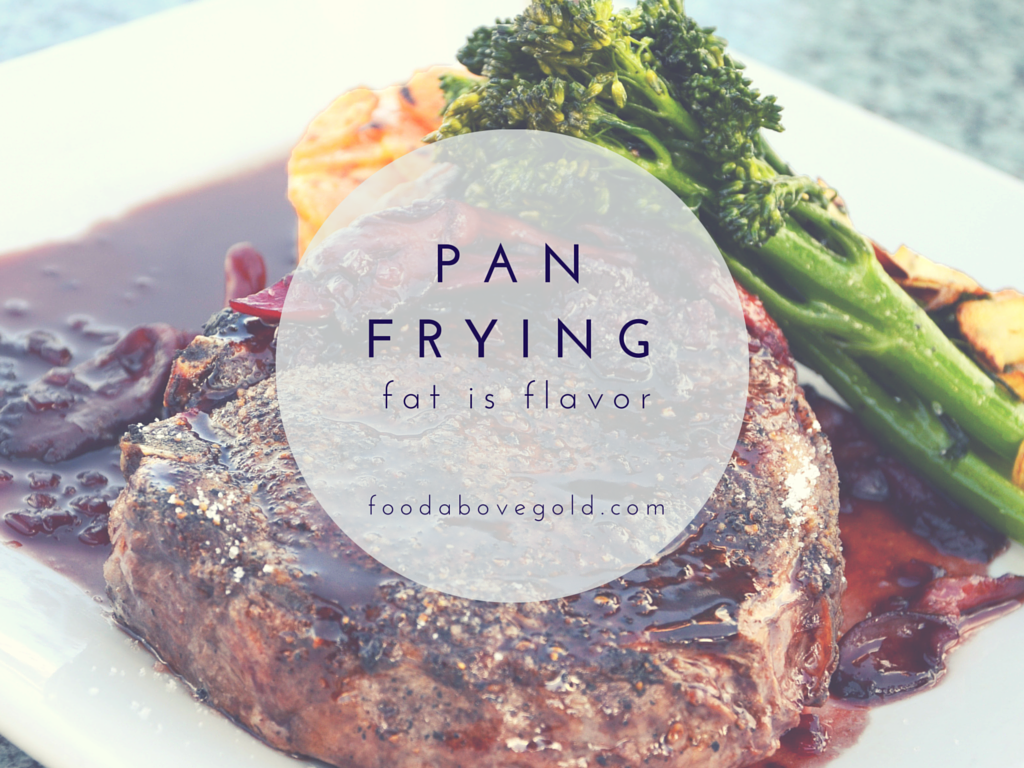Today we will be discussing pan-frying. Everyone loves a delicious pan-fried something or other, like chicken, or pork chops, but how does it vary from other methods and when should you use it?

What is Pan-Frying?
Pan-frying is simply cooking in a moderate amount of fat; compared to sautéing, which uses a small amount of fat, or deep frying, which is submersion in fat. Pan-frying is useful for when you want to create a beautiful, browned crust that enhances the flavor of your food and can be achieved by direct contact of the meat to the fat, or with additional flavorings like an herb crust, or a mustard rub.
Pan-frying does often take longer for the food to cook than sautéing and is usually done at a lower heat. It also often requires that the item be turned at least once for even cooking because it is usually used on larger pieces of food, like bone-in chicken thigh or pork chops. Because of the amount of fat (and the fact that you value your skin) used in pan-frying, turning is usually done with a spatula or tongs to avoid splashing fat on yourself, which would happen if you were trying to toss it like you were sautéing (not recommended).
Tip of the trade: In order to get a great crust on your food while pan-frying, most foods will stick to the bottom of the pan while there is still moisture in contact with the pan. Usually, they will release once all the water has been cooked off allowing for easy turning. To help with this, let your meat come to room temperature for 30 minutes to sweat out unnecessary moisture and blot it away with a paper towel before use. Don't worry though, this doesn't mean that the moisture has been removed from the inside (unless you let it hang out in the pan for too long), so you should not end up with a tough final product. Depending on the size of the cut, you may want to finish it by baking or roasting in the oven to prevent burning your crust (or just to get it away from cooking in excess fat), until the meat is done.
How much is a "moderate" amount of fat?
"How do I know how much fat to use?", you ask. Well, that depends on what you are cooking and how long you are cooking it for. For example, if you are frying an egg, you will probably only need enough fat to cover the bottom of the pan. The egg will cook fairly quickly, so you don't need to worry about evaporation or absorption. If you are making pan-fried pork loin, you could be using up to 1 inch or more of fat, and may still choose to finish it in the oven depending on how large it is. Also, the amount of fat necessary may be reduced if you coat your meat first. For example, if I am pan-frying herb crusted tilapia that has panko bread-crumbs surrounding it, I am actually frying the panko more than the tilapia itself. Since panko is naturally dry, I'm only really cooking whatever I've used to adhere it to the fish. This means I can usually use less fat than if I were to put the fish directly into the fat - but again, that may require baking it in the oven to finish it off so you don't burn the crust.
Now, let me clarify. A lot of times when you think about a coated food, you are thinking of battered food. Regardless of the fact that you are cooking in a pan, usually the amount of fat required to cook these is enough to cover them, or else your batter would run off into the oil before you had the chance to turn it - so in other words you deep frying in a pan. If it can float or completely submerge in the oil, you are deep-frying. This is a common mistake made in recipes. If I were to google pan-fried onion recipes, many of them on the first page would give me recipes that are deep-fried, in a pan. If you keep this in mind as you are reading through a recipe, it can help save you a lot of stress later.
Tip of the trade: Two for the price of one! To help prevent the oil in your pan from popping and splattering (hurting you and making a mess of you cooktop), add ¼ tsp. ground salt to the oil before heating. This doesn't completely eliminate the problem, but it does help reduce it. Plus, that means you don't need a splatter shield taking up you precious cabinet space.
Pan-frying is a great way to enhance flavor and serve up a beautiful meal. What tips and tricks have you found helpful when you are pan-frying?


What are your thoughts?